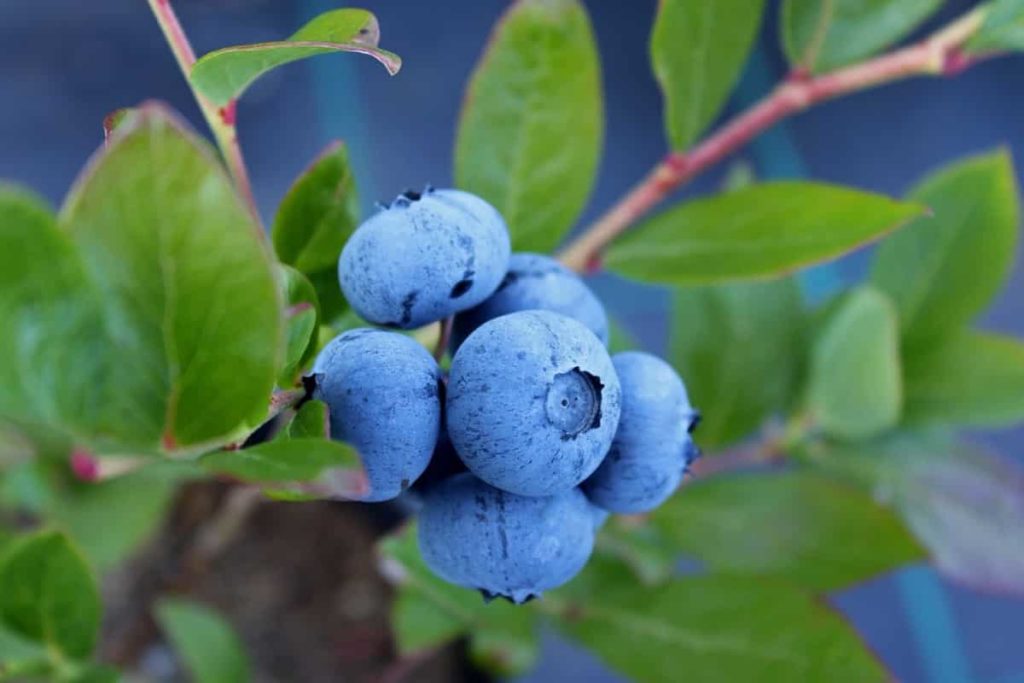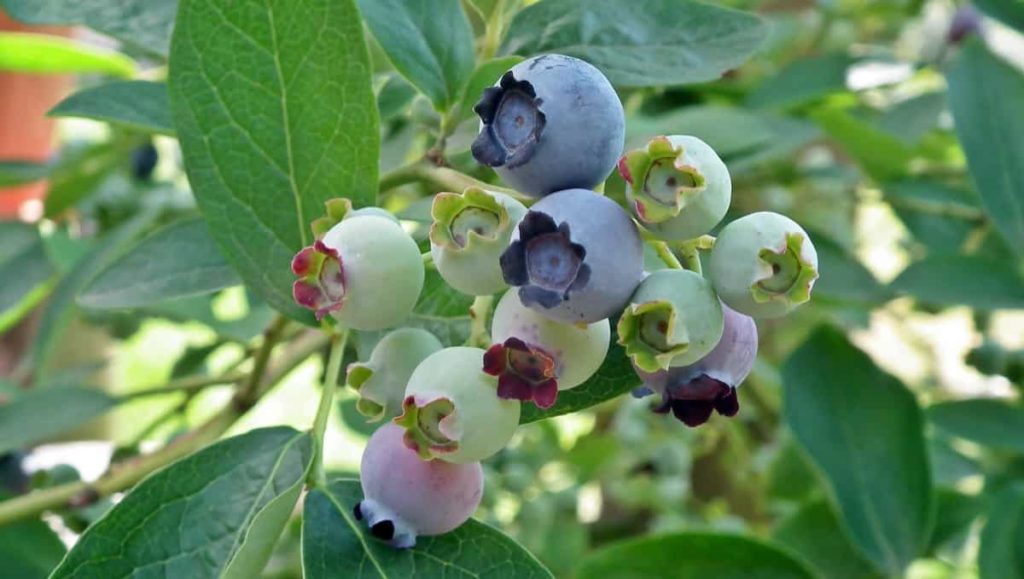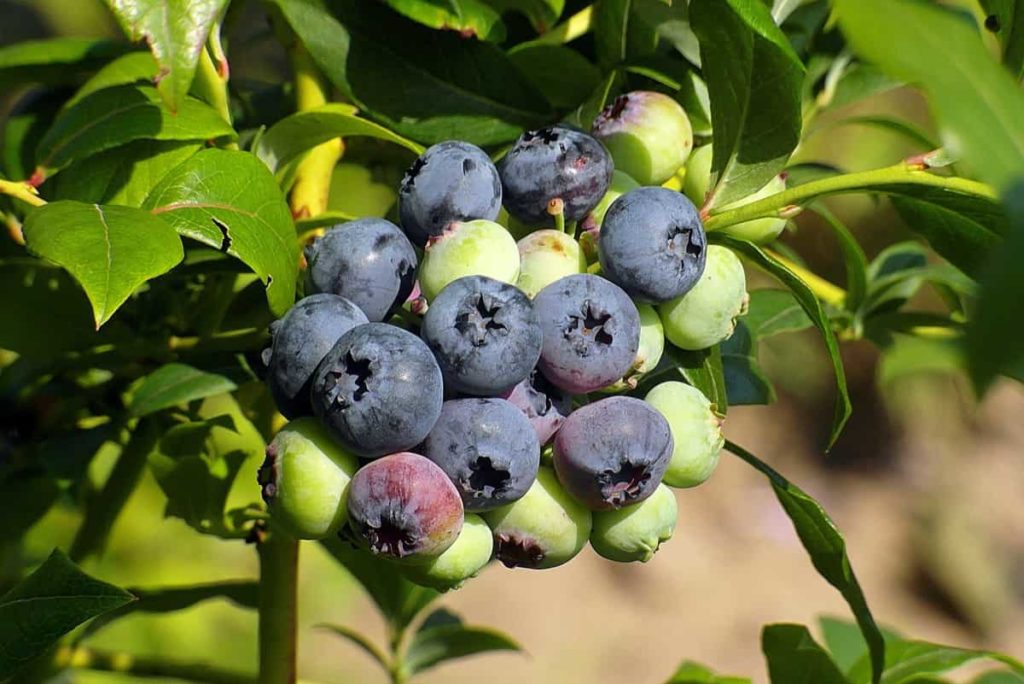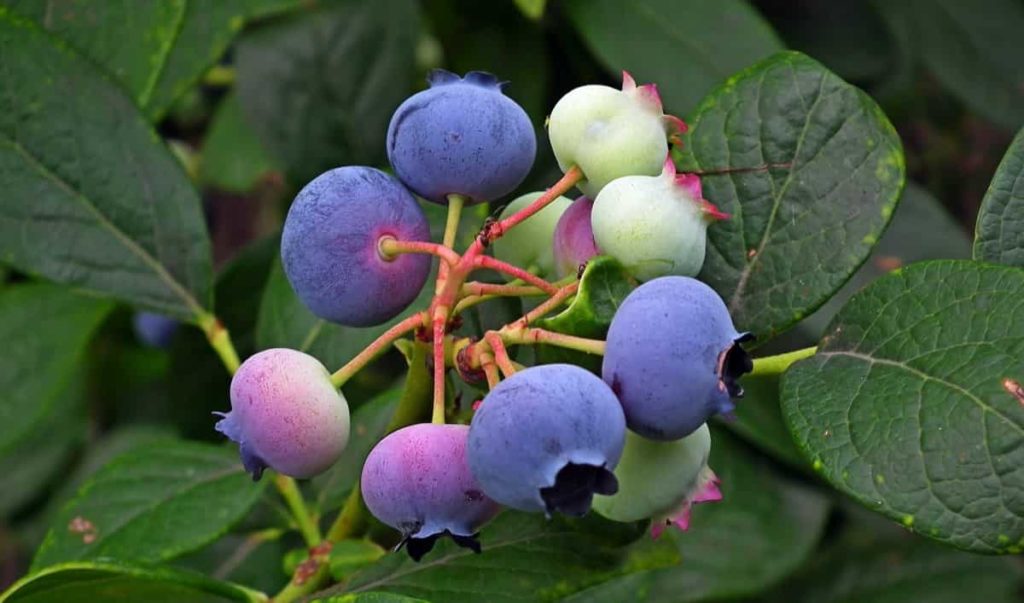Blueberries can be affected by many common diseases. New Blueberry farmers could be concerned if they don’t know how to treat the problem. While growing your herbs or plants can be a great experience, it can be equally frustrating when they don’t grow as expected for mysterious reasons.

Various Blueberry bush diseases can affect bushes, and you should know how to treat them and prevent future events. The biggest problems growing Blueberries are colorless leaves, Blueberry plants do not grow, curling, bending leaves, and plants not producing flowers.
17 Common Blueberry plant problems
Blueberry leaves turn brown
Your plant is not getting enough water. Young plants, in particular, are sensitive to this because their roots are still quite small, and the top of the soil dries up the fastest.
Solution – Young plants also have less shade, so the soil dries up quickly. More mature plants can take their water from berries, causing the fruit to wilt. Water your plants when the upper soil dries.
The plant will not grow properly if the plant does not get enough sunlight. Brown leaves can indicate that the plant is dying.
Solution – Blueberries need at least 6 hours of full sun and shade daily.
Blueberries grow best in acidic soils with a pH of 5.0. Growing plants above normal soil levels can be beneficial.
Solution – If the soil’s pH level is too high, you can reduce it by adding ammonium sulfate fertilizer, ground sulfur fertilizer, and sawdust to the soil.
Blueberry plants are not producing
The Blueberries should have no problems with the weather conditions. So don’t look up at the sky when your Blueberry stops blooming; focus on the soil instead. But even when those flowers, sometimes annual production is lower than usual, and that’s when you need to review the growing conditions around Blueberries more closely. Blueberries cannot flower because of the high soil pH.
Solution – If you see that blooming annually is below average, modify the soil pH. Add small doses of aluminum sulfate or sulfur to the soil and check for pH after each application. If you have only one Blueberry plant in the garden, consider planting another plant less than 100 feet away. Thus, bees and other pollinating berries will cross-pollinate and increase their production.
Blueberry plants will not produce berries in their first year, although they will have many flowers. Harvesting is important for Blueberry. You should do this every year when the plant is inactive. Aim to cut off about 20 percent of branches each time. In addition, remove any growth around the base of the plant.
The plant’s fertilization should start around the time of blooming in the second year and should be increased every year. Use ammonium sulfate and side-dress with well-balanced manure when needed.
In case you missed it: How To Start Blueberry Garden, Tips, and Techniques

Blueberry leaves turn yellow
Your Blueberry plant leaves may be yellow due to chlorosis. The leaves cannot produce enough chlorophyll if the soil’s pH level is too high.
Solution – Be careful when adjusting soil pH. The soil pH is above 5.5, and the blueberry plants do not grow well.
Blueberry leaves curling
Sunlight is essential for your Blueberry plant. If you’re looking at curling leaves on your plant, it may indicate that it’s not happening enough. Drought is undoubtedly crucial to its survival. When the plant dries up, the curling leaves can signify that it desperately needs some water. When insects sit on your plant leaves, they like to suck moisture and nutrients.
Solution – You should give enough water to the Blueberry plants. Blueberry plants thrive in full sun. You can remove the insects by using pesticides.
Blueberry plants are not growing
It can be unpleasant when your Blueberry plant is not growing while you are doing your best to make it flourish.
Drought – Drought can be a real problem for your Blueberry plant. Drought could be a very likely cause if it is not growing. As soon as the new plant grows leaves, it will need more water. After spring, warm summer, and dehydration can dry your young plant.
Solution – If you see this happening to your plant, remove the plant from the soil and replant it in summer or fall.
Soil – Another reason could be the level of soil pH.
Solution – Before planting your Blueberry plant, ensure the soil has pH levels between 4.5 and 5.5.
Fertilizer – When the Blueberry plant is not growing, many people like to give the plant more fertilizer. Some even go so far as to kill the plant with a huge amount of fertilizer.
Solution – The best thing to do is to get the plants out of the soil in spring or to fall and replant.
Blueberries are not ripening
Blueberries require a chill period to become ripe. In warm areas, berries may require longer periods to ripe than in cold areas. It may also relate to your growing cultivar. Some cultivars take more time to ripen. Soil acidity and lack of sunlight are key reasons for Blueberries will not be able to ripen. Soil pH should be between 4.5 and 5.0. But overall, if Blueberries are not ripe yet, it can only mean you need to give them more time.
Solution – You may have to do nothing to ripen Blueberries. It is because they will eventually ripen in quite chill hours. Chill hours are defined as periods when temperatures remain below -7°C. It also helps to take some steps to ensure that the Blueberry will ripen. Choose a cultivar that corresponds to your growing zone. Blueberries require 6 to 8 hours of full sun daily during the growing weather. So do not plant your Blueberry in the shade of a large tree.
Blueberries are sour
For the most part, Blueberries are sweet. Some cultivars have a light acidic lime or tarty flavor. But sour ripe Blueberry means something went wrong between pollinating the female flower and harvesting the mature berry. High productivity is one of the reasons why Blueberries become sour.
The plant has limited resources and cannot run with so many berries at a time. You picked them very quickly. Blueberries need to be ripened on branches. Some of the cultivars won’t pick up at the same time. So, pick berries from different places on the plant and taste them before harvesting your Blueberries.
Solution – If you look at branches covered with too many berries for later years, thin them to increase crop size and sweetness. Make sure that the soil acidity is between 4.5 and 5.0. Fertilize the Blueberry with ammonium sulfate after the flower blooms. Sample your Blueberries before deciding that all the berries are ripening and ready to harvest. If you have already harvested sour berries, spread them over a dry sheet in a dark room and place some Apples or Avocados in them. It will soften the berries even if the taste may not improve.
In case you missed it: Best Fertilizers for Strawberries: Homemade, Organic, Compost, Liquid, NPK Ratio, and Schedule

Blueberry plant is not flowering
If your Blueberry plant is not flowering, you can understand many reasons behind it.
Solution – Make sure your plant gets enough sun. Blueberry plants don’t want wet roots; ensure good drainage. Ensure the correct pH level of the soil.
Pests
Flea beetles
In the winter, you can find Blueberry flea beetle eggs on a plant base. Once immature Blueberries develop in spring, the eggs hatch into larvae that start feeding leaves on plants. It maintains larvae as they grow in the pupae. The pupae bore in the soil in preparation for adulthood. When adults emerge, they will continue to eat Blueberries until the end of summer, meaning they attack plants during their most productive cycle.
Solution – Regularly monitor your grounds during their early blooming period to ensure you catch the problem with flea beetles before wreaking havoc on your crop. If you see defoliation, there are no Blueberry bush leaves; the best course of action is to spray the ground before the larvae turn into adults. It allows you to catch most larvae that can’t escape like adults.
Fruit worms
These fruit worms are reproduced brown or black grey moths that lay their eggs next to the floral-small green fruit from the blossoms. When they eat developing fruits, they leave behind brown frass and silky web.
Solution -You can monitor male moths using pheromone traps to see the extent of the attack on your hands. Keep the traps while blooming. If these interventions indicate the possibility of a fruit worm infestation, apply pyrethroid, organophosphate, carbamate, growth regulators, and a neonicotinoid. Cultural methods to reduce this problem include cleaning weeds and garbage around plants. If they appear in your yard, you can manage by hand picking affected fruits and destroying them.
Blueberry maggots
Larvae affect the ripening fruit; as they eat the berry from within, the fruit becomes soft as it progresses. The maggots eat berry for three weeks, after which they fall to the ground.
Solution – Monitor your bushes for a few weeks before the Blueberry ripens. Sticky cards attract and trap flies. Once you look at several flies on the traps, immediately start treatment using natural active ingredients like chemicals like spinosad or novaluron.
In case you missed it: Growing Strawberries In Greenhouse – Polyhouse

Sharp-nosed leafhoppers
As a result of this pest attack, the Blueberry plant does not produce fruit due to stopping growth. Sharp-nosed leafhoppers spread phytoplasma in the bushes, causing stunt disease.
Solution – The treatment of these pests should focus on the perimeter of Blueberry fields as they come from the woods. When they try to migrate to the field, killing them is more effective than trying to eradicate them when they join the crop.
Thrips
The thrips live in Blueberry plant flowers, where they suck juice into flowers. Both larvae and adults eat from flowers, reducing the amount and quality of the Blueberry that has been slaughtered. Thrips eat the pollen in flowers, which causes fruit abortion. When the female lays eggs, they stain the fruit, making it ugly. If they are commercial production, it reduces the capacity of the berries.
Solution – Use a zip-lock bag and collect flowers randomly from different bushes in your field in each bag. If bags are obtained between two and six trips per flower, it is time to apply the treatment extensively. 2 to 6 may seem small; still, they are enough thrips to cause significant injury to an individual Blueberry flower.
Pesticide is the most popular treatment applied to Blueberry bushes that are affected by thrips, but you should choose options that do not affect pollinators like bees. Spinosad is a safe option effective against thrips, but it is also friendly to flies. Insecticidal soaps and narrow-range horticultural oils are also safe for pollinators and other natural enemies of thrips.
In case you missed it: Growing Organic Strawberries On Terrace – In Pots

Diseases
Stem canker
The disease is characterized by red lesions on the trunks of Blueberry bushes. The lesions are small at first, but they spread and grow over time, causing deep cracks on the stem. Stem canker treatment is exceptionally difficult as the fungus that causes it is not accountable for fungicides treatment.
Solution – The only thing that can save your bushes is the rapid action on your part, pruning six to eight inches away from the stem at the lowest point of the disease. Burn the affected stems instead of burying them. The main course for experienced gardeners to stop and control stem canker is to pay close attention to the Blueberry bushes they have bought.
Phytophthora root rot
It is the most common disease affecting Blueberries. It is characterized by the fact that Blueberries are not growing as healthy as neighboring plants and have red leaves. When you look at the plant’s roots, they have lesions on the roots of the small feeder. As it progresses, the above-soil symptoms become more pronounced as the leaves turn yellow faster. Blueberry leaves turn yellow. Usually, gardeners find phytophthora underground to rot roots.
Solution – Use fungicides (not to treat severely diseased plants) as a disease drench around the base of infected plants. Stresses such as high fertilization with nitrogen and weed injury appear to accelerate the death of affected plants.
Crown gall
Crown Gall affects the entire plant, starting with the stem where the bulges will grow near the roots. It is a bacterial disease in airy soil, such as sandy loam. You will see tumor-like circles on the base of the canes, the roots, or on the lower stems of the bush.
Solution – Use a knife to remove the galls. Seal the wounds on the stem. Remove the plant if it does not improve.
Silver leaf
Like many other Blueberry diseases, silver leaf affects the bush through cuts and lesions in the stems and limbs. Inoculum sources are spores on pre-infected bodies blown off the air and attached to new plants. The young Blueberry leaves turn silver. It may start on a few branches but gradually spreads throughout the bush. Roots may be intact, but the infected stem can reveal a brown heart with purple-brown concentric rings. Moreover, the plant will show discoloration at the affected branches’ base and trunk.
Solution – Unfortunately, once the plant has already been contaminated, there is no way of controlling it. Destroy plants that show signs and make sure to clean the debris of any plant. Apply chemical agents to protect any wounds or pruning in the bush.
In case you missed it: Hydroponic Strawberry Gardening Techniques, Tips

Conclusion
Blueberry bush can be productive for up to 50 years as well. These are not high-maintenance plants, but numerous problems can also affect their growth. Avid gardeners face problems growing Blueberry plants, either having pest-related or fungal diseases. Environmental stress factors occur; however, you can prevent them by controlling the place where you grow plants. This article explains common problems, diseases, and pests affecting Blueberries and possible solutions to cure them.
- Broccoli Seed Germination and Selection
- Asparagus Seed Germination and Variety Selection
- Seasonal Flower Gardening: Best Practices for Spring, Summer, Fall, and Winter
- How to Grow Hibiscus from Flower
- Plantation Ideas for Home Decoration: A Beginners Guide
- Flower Garden Designs and Layouts for Beginners
- Planting and Spacing Techniques in Papaya: A Beginner’s Guide
- Growing Gold: Essential Techniques for Planting Pineapples
- How to Make Kalanchoe Plant Bushy: Home Remedies and Solutions
- 11 Reasons Why Your Gardenia is Not Blooming: Home Remedies and Solutions
- Eco Elegance: The Guide to Designing a Drought-Tolerant Landscape
- Gardening on a Slope: Strategies for Hillside Landscaping
- Nourish and Flourish: Top Organic Mulches for Thriving House Plants
- Everything You Want to Know about Indian Mogra Flower: Discover Uses and Growing
- Green Thumb Success: Expert Tips for Cultivating Greenhouse Pumpkins All Year Round
- Maximize Growth & Flavor: The Ultimate Guide to Companion Planting in Herb Gardens
- How to Control Rhododendron Problems Naturally: Home Remedies and Organic Ways to Fix Them
- Natural Magic: The Remarkable Benefits of Cinnamon for Plants
- Best Steps to Revive Dying Tulip with Natural and Organic Treatment
- 10 Reasons Why Your Angel Trumpet is Not Blooming: Remedies and Treatment
- How to Fix Periwinkle Leaf and Flower-Related Problems: Natural Remedies and Solutions
- How to Fix Zinnias Leaf and Flower Problems: Discover Natural and Home Remedies
- Organic Steps to Induce Lemon Tree Flowers: A Comprehensive Guide
- Bloom Booster: Crafting the Perfect Homemade Bougainvillea Fertilizer
- Optimizing Growth: A Guide to Applying NPK Fertilizer for Potted Plants
- 10 Best Homemade Fertilizers for Rubber Plant: DIY Recipes and Application Method
- How to Boost Female Pumpkin Flowers: Effective Steps for More Flowers and High Yields
- Transform Your Indoor Garden: Top Benefits of Pink Salt for Houseplants
- 10 Best Homemade Fertilizers for Peacock Plants (Calathea): Easy DIY Guide
- Unlock Blooms: 9 Reasons Why Your Potted Chrysanthemum is Not Blooming
- 8 Reasons Why Your Potted Hibiscus is Not Blooming: Fix it with Simple Solutions
- Unlock Blooms: 9 Key Reasons Your Potted Frangipani Won’t Flower
- 10 Reasons Why Is My Ice Plant Not Blooming: Remedies and Treatment
- 10 Reasons Why My Potted Hydrangea Not Blooming: Treatment and Remedies
- 10 Reasons Why is My Wisteria Not Blooming: Remedies and Treatment